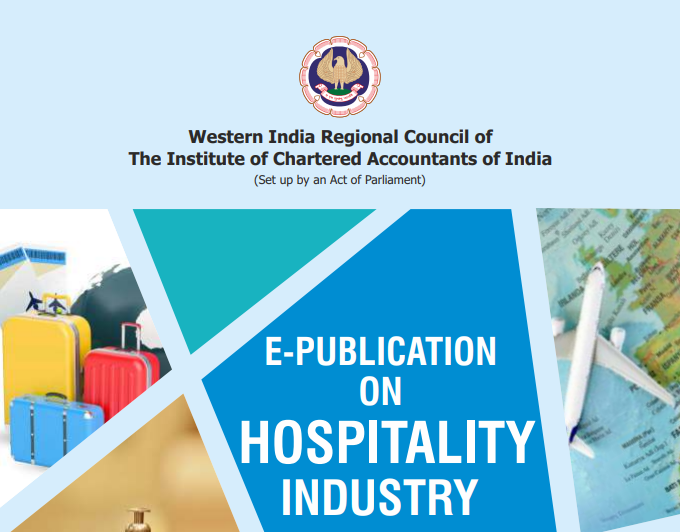E-Publication On Hospitality Industry: ICAI
1. Introduction
1.1 Global Scenario
Hospitality Industry is an integral part of the Travel and Tourism sector across the globe and also has strong relevance to the Business Community as one of their customer segments, in addition to Travelers – International or Domestic.
Globally, this industry is a significant contributor to the country’s Economy from various dimensions and India is no exception to this phenomenon.
Be it Business, Leisure, Wellness, Medical, Cultural, Heritage, Sports, Adventure, Spirituality aspects, different countries have different attractions for travelers depending upon the geography, topography, demography, traditions, customs, history, cuisine, and even business offerings. While the Social, Political, and Economic scenario plays an important role in the development of this sector, Nature too determines the significance of this sector in Economics, partly or wholly.
Looking at the opportunity this sector has to offer, with an increase in spending in emerging economies, a good number of business houses have built their brands with their chains of hotels and resorts across the globe while some have even carved out a space for themselves with their chains of restaurants, health clubs.
1.2 India Scenario
Ministry of Tourism promotes and governs the Tourism and Hospitality Industry. Apart from Leisure, Wellness, Medical, Cultural, Heritage, Sports, Adventure, Spirituality aspects, the Indian Government has also been encouraging Eco-Tourism and Rural Tourism in order to have the last mile reach.
Over the years, India has seen steady growth in International and Domestic tourists with better spending capabilities coupled with better infrastructure in the form of more Airports, Roadways, Waterways, and Railways connectivity as well as maintenance and upkeep of heritage sites and a couple of key Forts warranting more and variety of Accommodation, F&B outlets, and activity options, to cater to different classes of tourists.
Technology has also played a dominant role in the form of reservations/ bookings, tour aggregators for tour bookings, and travel plans, thereby bringing in convenience and competitive advantage. Additionally, Technology also brought in ease of capturing and maintaining the flow of different types of transactions that Hospitality Industry units generally enter into.
India’s geographical and cultural diversity, rich heritage, historical forts and monuments, beautiful landscape, a long coastline, forest cover, snow-capped mountains, ancient temples, places of pilgrimage, a mix of urban and rural flavor, growing economy, are conducive factors that have boosted Tourism both inbound as well as outbound. It hosts a range of Hotels, Resorts, Wellness retreats, Convention Centers, Amusement Parks, Local and Multinational chains of restaurants, cafes, fine dining outlets, service apartments, budget hotels, tour operators as well as aggregators to cater to the ever-increasing demand. Robust infrastructure which is being enhanced, to further give a boost to economic and social development, will prove to be an advantage to Tourism and Hospitality in the years to come.
Central and State government machinery go hand in hand to ensure balanced economic growth.
2. Scope
Hospitality Industry, with its unique features, warrants the separate attention of CA professionals. This industry includes multiple businesses that can be either stand-alone or can also be clubbed as a package, demanding due consideration of different statutes that govern different types of transactions and their cognizance and treatment in the financial statements. Hospitality is both Capital intensive (mainly land and building) and labor-intensive. This industry includes domestic as well as international players. The role of professionals could be right from project financial planning till liquidation.
There are different ways in which Hospitality units are run. They could be owned and operated by the same entity or could be leased to another for operations or there could be a management contract for managing the operations or they could be run on a franchise model.
Depending upon the businesses a unit is into, there would be key sources of revenue peculiar to the Hospitality Industry and key expenses relevant to those businesses.
This Paper would be covering the Accounting, Taxation, Audit, and Compliances related to the Hospitality Industry
Nature of Businesses that would be covered are:-
1. Hotels and Resorts
2. Restaurants and Fine dining outlets
3. Service apartments and Homestays
4. Banquets and Convention Centers (MICE offerings)
5. Clubs
It would be important to note here that though there could be some areas common to all the above, there are and there could be differences in the range and type of offerings in each of these categories. For example, Hotels and Resorts would have accommodation facilities as a common feature whereas the difference could be in the other services and activities that would be offered to guests availing them. Hotels would have more offerings to the business needs of guests whereas Resorts would cater more to Leisure requirements. Similarly, Restaurants and Fine Dining would have Foods and Beverages as a common feature however type and range of cuisines would differ as would be the different tastes of a different class of guests/customers availing them.
Serviced apartments are a relatively recent concept where typically they would have long staying guests and the apartments would be equipped with most of the gadgets and services that are required by guests on a daily basis with an additional flavor of DIY (Do It Yourself). Homestays are again budget facilities created in areas where tourists prefer to spend more time in Nature or move around to see nearby attractions with only a basic requirement of Lodging and either a basic breakfast or dinner.
Banquets and Convention centers cater to MICE (Meetings, Incentives, Conferences, and Exhibitions) and could differ in the scale and nature of guests availing these services. While Banquets would cater to family, social and small corporate functions, Convention centers could house big corporate events or seminars. Similarly, Clubs would have the common features of memberships however the offerings could differ from club to club.
A new concept of Airbnb has brought in a different way of letting out vacant properties for travelers by small property owners which fills the demand-supply gap in an economical way.
3. Statistics
3.1 Few facts and statistics
- With a consistently growing middle class and increasing disposable income, the tourism and hospitality sector was witnessing healthy growth; accounting for 9.2% of the country’s GDP in 2018.
- India was ranked 34th in the Travel & Tourism Competitiveness Report 2019 published by the World Economic Forum.
- As of 2019, 4.2 crore jobs were created in the tourism sector in India which was 8.1% of Total Employment in the country.
- According to WTTC, India ranked 3rd among 185 countries in terms of travel & tourism’s total contribution to GDP in 2018.
Read & Download the full Copy in pdf:
If you already have a premium membership, Sign In.
 ConsultEase Administrator
ConsultEase Administrator
Consultant
Faridabad, India
As a Consultease Administrator, I'm responsible for the smooth administration of our portal. Reach out to me in case you need help.













